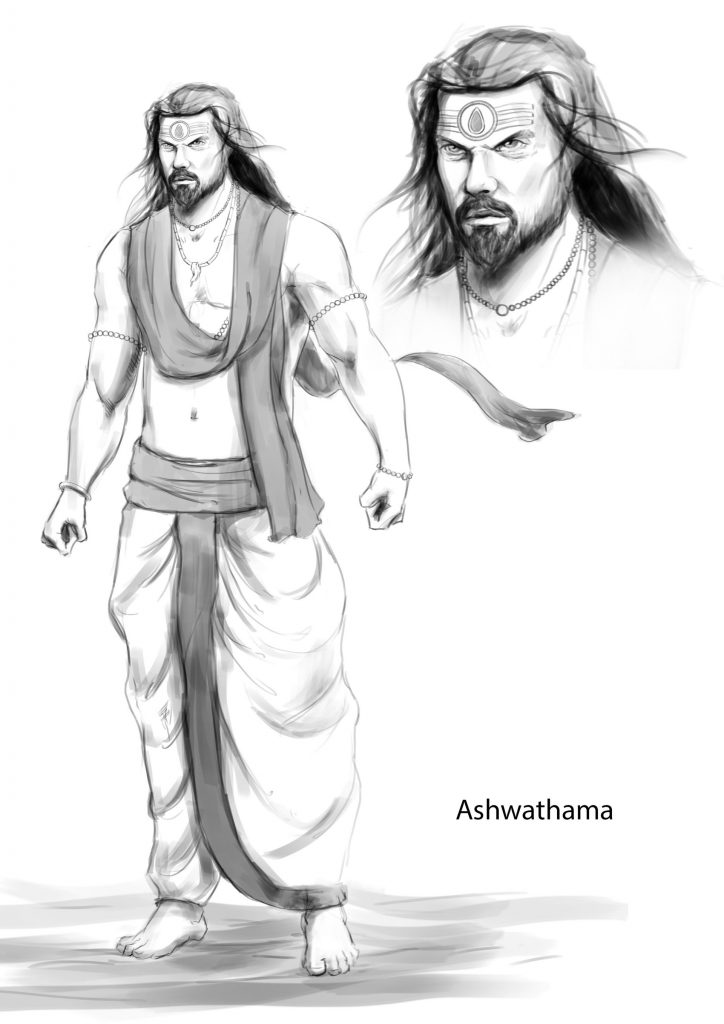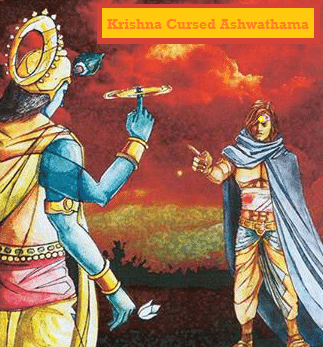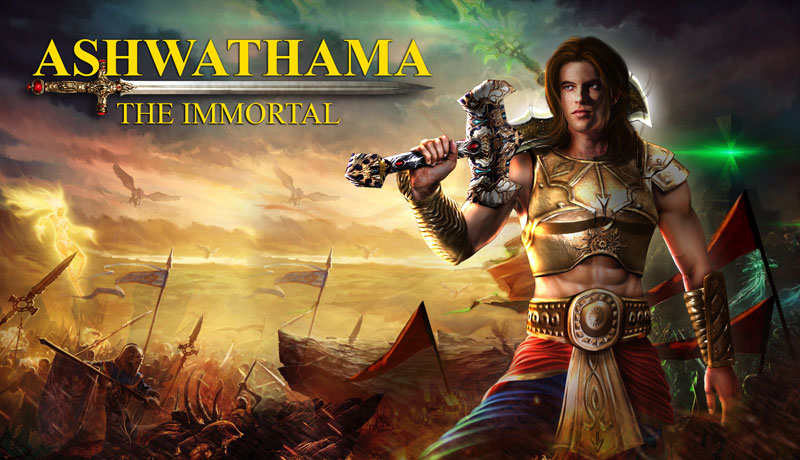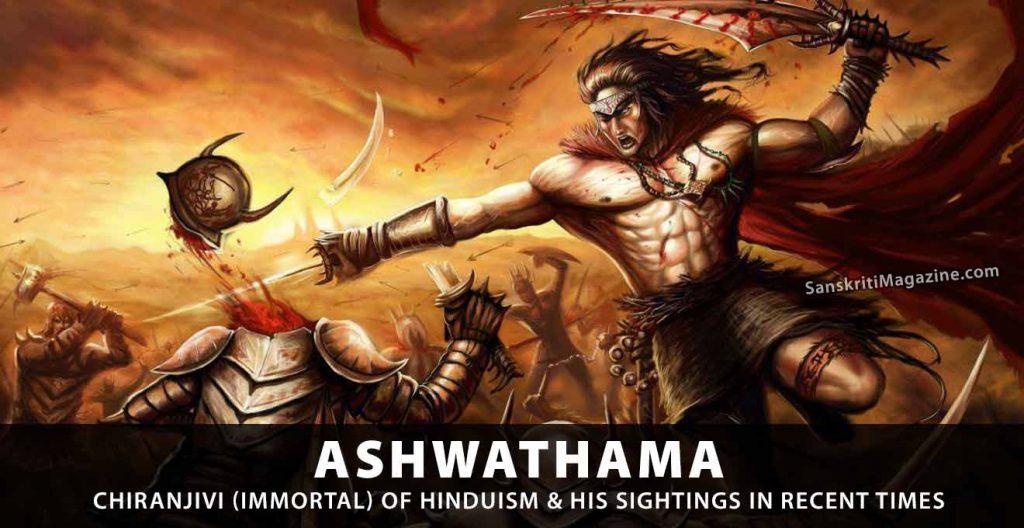Ashwathama was the son of Dronacharya, teacher of Kauravas and Pandavas in the Dwapar Yuga (the third age of the four ages, Sat, Treta, Dwapar and Kali). His mother’s name was Krupi. It is said that at the time of birth there was a sound of neigh from his throat that is why he was named Ashwathama (Ashwa means horse in Sanskrit). Ashwathama had a valuable gem or “Mani”, set on his forehead, the wearer of which ceases to have any fear from weapons or disease or hunger, and ceases to have any fear of gods, Danavas (a race of the Demons) and Nagas (a deity or class of entity or being, taking the form of a very large snake, found in Hinduism and Buddhism).
He was very heroic and an expert archer. In the war of Mahabharata, he was the commander of the army of the Kauravas. In the war, to defeat Dronacharya Sri Krishna planned a clever war tactic. On the side of Pandavas there was an elephant by the name of Ashwathama. Shri Krishna told Yudhishthira to spread the rumor that Ashwathama was dead! The elephant was killed and everyone shouted, “Ashwathama is dead, Ashwathama is dead!” Dronacharya also heard these words and suspected his lone son Ashwathama was killed in the battle. Gloomy at the loss of his son he approached Yudhishthir and asked, “O Yudhishthira, I know you never speak untruth, please tell me what has happened. Is Ashwathama really dead?
With great effort Yudhishthira said, “Yes, Ashwathama is dead”; but added in whisper, “I do not know whether he is a man or an elephant.” Dronacharya in the din and bustle failed to hear the second half of the sentence and thinking that his loving son has died gave up the fight and was subsequently killed by by Dhristadyumna, son of Drupad.

Here Ashwathama, son of Dronacharya, learnt about the trick played by Sri Krishna and Yudhishthira in the killing his father. To take his revenge, at the end of Mahabharata, one night Ashwathama went to the Pandavas camp. Pandavas were not present in the camp at that time. Thinking that the Pandavas were sleeping, Ashwathama killed all the five sons of Pandavas and also the baby in the womb of Uttara, wife of Abhimanyu (Arjun’s son). Shri Krishna revived the stillborn child. This child further became famous as King Parikshit.
Draupadi started lamenting at her sons being killed. When Pandavas returned to their camp and came to know that Ashwathama had killed their sons, they were very angry. Here, even Ashwathama was scared and knew that Pandavas will not spare his life. He ran away and hid himself in the forest on the banks of River Ganga. There, Sage Maharishi Vyas was sitting with few other Sages. Pandavas came there in search of Ashwathama and Arjun challenged him for a battle. Frightened Ashwathama propelled the unfailing weapon Brahmastra (a kind of weapon which dealt infallible destruction and was set in motion by the force of mantras). Arjun also had the knowledge of Brahmashtra and he also used the same to reduce the effect of Ashwathama’s weapon.
With the collision of these weapons, it was feared that the whole universe might be destroyed. Then, Sage Maharishi Vyas and Narad made these weapons inactive with their powers. Arjun was about to kill Ashwathama, but in the honor of Maharshi Vyas, Narad and others, he left him alive and snatched away the “Divya mani” (Divine gem) from him. At this sinful act of Ashwathama, Shree Krishna was very upset and cursed Ashwathama that he will be wandering on this earth for thousands of years and always a foul smell will come out of his body due to which he will not get a place in the human society. He will wander in the jungles and live a cursed life. It is believed that even today Ashwathama is roaming around in the jungle suffering the punishment of his sinful act.
It is believed that he is cursed to remain alive till the end of the Kali Yuga. An old fort near Burhanpur, India called Asirgarh has a Lord Shiva temple on top where it is believed that Ashwathama offers a red rose everyday to Lord Shiva early in the morning. It is said that as Krishna took away the gem from his head, Ashwathama is seen wandering with his head bleeding.
Incident 1 – Ashwathama seen by Railway Employee
A more than a decade old newspaper article ran about a railway employee on leave. During his wanderings in the jungles of Navsari (Gujarat) he had reported a very tall man of about 12 feet with a wound on his head. He claimed to have conversation with him and learnt that Bheem was much taller and stronger than him.
 Incident 2 – Ashwathama met Pilot Baba ?
Incident 2 – Ashwathama met Pilot Baba ?
The last record of his existence came to my notice while reading a book called “Himalaya kah raha hai” by Pilot Baba. you can also go to his website to read the excerpts. The temple where he stayed was washed away in the floods a few years back. But before that he had interesting encounters with Aswathama which he shared and we have detailed as incident 9.
Incident 3 – Prithviraj Chauhan Hindu King Meeting Ashwathama
When in 1192, Prithveeraaj Chauhaan lost the battle from Mohammad Gauree, he left for jungle. There he met one old person with a scar on his head. Being a very good doctor Prithveeraaj Chauhaan confidently asked him that he can cure his scar. The old man agreed. But even after week’s medication it remained as it is. Prithveeraaj was surprised and understood the details. He asked old man if he is Ashwatthaamaa. Because only the scars that is created through taking up the “MANI” the gem from forehead cannot be cured. The old man told that he was Ashwatthaamaa and then he went away. This description is given in “Prithviraj Raso” the book written in 12th century on him.
Incident 4 – Ashwatthama Ecounter with Saint Naranappa
In late 14th, early 15th century there lived in Gadag, Karnaatak, a poor Braahman called Naranappa. Later, because of the Mahabharata epic “Karnata Bharata Kathamanjari” that he wrote in Kannada, he came to be called as Kumara Vyasa. His greatest desire was to write Mahaabhaarat based on original sources, and to this end he prayed day-in and day-out in the Temple of Veera Naaraayan, temple of Trikooteshwar. One day the Almighty decided to answer his prayers and appeared in his dream and said: “Attend the forthcoming Dwaadashee Paaran (Dwaadashee feast) in the Veera Naaraayan Temple. Watch out for one lone Braahman who would leave the feast earliest. He is none other than Ashwathaamaa who witnessed Mahabharat. Fall at his feet and ask him to narrate the MahaBharat as it happened. You can record it in writing and claim your share of fame”. Promptly Naranappa (Narayanappa) attended the following Dwaadashee Paaran at the Veera Narayan Temple, and then followed the Brahmin who finished his feast the earliest and started walking out of the Temple. He approached him and fell at his feet saying, “I know who you are, you are the very same Ashwatthaamaa of MahaBharat, please help me”. At this Ashwathaamaa was taken aback and asked him how do you know this? Naranappa responded saying “The Veera Naaraayan Swamy” appeared in his dream and told me so. Ashwatthaamaa was mightily pleased hearing this and asked Naranappa, OK, tell me what can I do for you. Naranappa responded saying he would like to write the Mahaabhaarat in Kannada as it happened.
To this Ashwatthaamaa agreed under two conditions. He said that Naranappa should start writing the Mahaabhaarat everyday after he finished his bath, wearing a wet Veshti (Dhotee). Ashwatthaamaa said – “You can keep writing till such time your Veshti is wet and the MahaBharata would flow from your pen as it happened. The moment your clothes dry up, the flow would stop. He also put a condition that he should not disclose this secret to anyone failing which the flow would stop forever. Needless to say, our Naranappa, was immensely excited about the project, and he kept his secret till the time he reached the “Gadaa Parv” (the time when Duryodhan and Bheem fought the duel of the mace fight). At this moment it is believed that Ashwatthaamaa appeared before Naranappa and he was in tears — remembering his friend Duryodhan and the A-Dhaarmik (unjustified) way in which Bheem defeated Duryodhan. Naranappa overcome with excitement disclosed this secret to his wife, and his writing flow stopped immediately. That is why his Mahaabhaarat ends with Gadaa Parv only. Later someone might have added up from Vyaas’ MahaBharat, but our Kumara Vyaas’s MahaBharata ended only with Gadaa Parv. End of Mahabharat and Beginning of Kaliyuga further suggest that Dronacharya’s son is very much alive and is bound to roam in India to serve the curse bestowed on him. The curse that “Ashwatthaamaa would roam the world carrying his own sins, with people shunning him, and suffering the pain of the wound on his forehead from where the “Mani” was removed by force”, 5000 years ago. Or Vikram Samvat 2070** years, since Mahabharata is now long passed, and I am sure, Ashwatthaamaa is there somewhere in the Himaalaya, performing Tapasyaa. (**Vikram Samvat is calendar derived by King Vikramaditya to record historical evidences).
Incident 5 – Aswathama Meeting Parents of Swaminarayan
Dharmdev and Bhaktimaataa (father and mother of Swaminarayan) were cursed over two hundred years ago by Ashwatthaamaa – son of Dronacharya. This is described in Satsangi Jivan written by Shatanand Muni – He was tall and well built robed in orange clothes as a Braahman. His head was strapped just above his eyebrows and he was covered with Bhasm (ash). He had big red eyes full of angerness. Mother Bhakti and father Dharm were on their way back from Vrindaavan where Shree Krishn proclaimed to them that their troubles in Chapaiyaa (village close to the banks of Sarayoo) would soon end after He himself would be born to them.
To this Ashwatthaamaa agreed under two conditions. He said that Naranappa should start writing the Mahaabhaarat everyday after he finished his bath, wearing a wet Veshti (Dhotee). Ashwatthaamaa said – “You can keep writing till such time your Veshti is wet and the MahaBharata would flow from your pen as it happened. The moment your clothes dry up, the flow would stop. He also put a condition that he should not disclose this secret to anyone failing which the flow would stop forever. Needless to say, our Naranappa, was immensely excited about the project, and he kept his secret till the time he reached the “Gadaa Parv” (the time when Duryodhan and Bheem fought the duel of the mace fight). At this moment it is believed that Ashwatthaamaa appeared before Naranappa and he was in tears — remembering his friend Duryodhan and the A-Dhaarmik (unjustified) way in which Bheem defeated Duryodhan. Naranappa overcome with excitement disclosed this secret to his wife, and his writing flow stopped immediately. That is why his Mahaabhaarat ends with Gadaa Parv only. Later someone might have added up from Vyaas’ MahaBharat, but our Kumara Vyaas’s MahaBharata ended only with Gadaa Parv. End of Mahabharat and Beginning of Kaliyuga further suggest that Dronacharya’s son is very much alive and is bound to roam in India to serve the curse bestowed on him. The curse that “Ashwatthaamaa would roam the world carrying his own sins, with people shunning him, and suffering the pain of the wound on his forehead from where the “Mani” was removed by force”, 5000 years ago. Or Vikram Samvat 2070** years, since Mahabharata is now long passed, and I am sure, Ashwatthaamaa is there somewhere in the Himaalaya, performing Tapasyaa. (**Vikram Samvat is calendar derived by King Vikramaditya to record historical evidences).

Incident 5 – Aswathama Meeting Parents of Swaminarayan
Dharmdev and Bhaktimaataa (father and mother of Swaminarayan) were cursed over two hundred years ago by Ashwatthaamaa – son of Dronacharya. This is described in Satsangi Jivan written by Shatanand Muni – He was tall and well built robed in orange clothes as a Braahman. His head was strapped just above his eyebrows and he was covered with Bhasm (ash). He had big red eyes full of angerness. Mother Bhakti and father Dharm were on their way back from Vrindaavan where Shree Krishn proclaimed to them that their troubles in Chapaiyaa (village close to the banks of Sarayoo) would soon end after He himself would be born to them.
On the way back one night (it took 28 days for them to get back to chapaiyaa village – the birthplace of Swaminarayan Bhagwan), as they walked through the forest they lost their way. They saw a tall Braahman roaming in the forest. They asked him for direction. The Braahman with a deep voice asked where they were coming from as they looked feared. Dharmdev explained that they were a Sarvariyaa Saam Vedee Braahman and his Kuldev was Hanumaan Jee and up on Hanumaan Jee’s advice at Hanumaan Garhee -Ayodhyaa (where Dharmdev did Tapascharyaa for 3 months) they went to Vrindaavan. Dharmdev further explained the whole incident as well as telling him how they had a revelation from Lord Krishn and Shreemati Raadhaaraanee in Vrindaavan. With this the Brahmin spoke with anger in his voice “Krishna my arch enemy? Will be born to you? I curse Him for the pain I have borne as of Him, that He as your son will never be able to bear weapons and neither shall he be able to fight in any war.” Saying this he left pushing Dharmdev aside. Bhaktimata started trembling and crying. Just then Hanumaan Jee arrived to them once again and calmed them and showed them the way and told them that they need not fear as God does not need any weapon nor need to fight to rid evil and tyranny. This incident shows that Ashwatthaamaa is still roaming in forests and jungles of India today. As this was just over 200 odd years ago.
Incident 6 – Aswathama Seen in Ludhiana, Punjab
Narrated by a commenter. My Father’s uncle was a famous (Vaidya) – Doctor in Ludhiana. He would spend hours meditating too. He was a Bhakt of Data Dayal, a well Known Guru in Panjaab (try to search for Data Dayal on net). One day as he was closing his shop in the after noon, it was summer time and everything was shut due to summers, in 1968-69, Ludhiaanaa, Panjaab, just then an old person came to him, whose face was covered and spoke to him in crude Panjaabee and Hindi mix, “Badaa naam sunaa hai teraa, bhaut badaa vaidya hai too? Ilaaj kar sakdaa hai meraa? My father’s uncle said – “Tell me what the problem is?” and when he removed the Pagadee from his head, there was a dent on the forehead. He had never seen such a dent before, as if the brain was taken away from the fore front, yet the skin was tight as if nothing had happened. My dad’s uncle was a bit nervous but still said that he would like to have a second look at him. He said – “Tenu pataa hai main kaun hoon?” and my dad’s uncle said – “I think I know who you are but still let me get my stuff.” By the time he brings his stuff from the almirah, that man had left, never to be found again. But he said that his eyes always haunted him, He had blue eyes, which were so sharp as if he would walk inside his brain.

Incident 7 – Aswathama seen nearby Narmada river (Gujarat)
Narrated by another commenter. I have also heard from numerous people that others have spotted someone with a dent in the forehead roaming around the Narmadaa river (Gujaraat). He was described as tall person, and that there were tons of flies, bugs surrounding him all the time.
Incident 8 – Vasudevanand Saraswati Met Ashwathama in Shoolpaneeshawar
Vasudevanand Saraswati, a saint who is considered as incarnation of Dattatreya by his followers, saw Ashwatthama in the dense forest of Shulpaneeshawar near Katarkheda*, in the year 1912 (2 years before he took samadhi on Mangalwar, Nakshatra Ardra, Ashadh Shuddha Pratipada).
*Katarkheda is small village located in Dahi Tehsil of Dhar district, Madhya Pradesh
In 1912 Chikhalada, 22nd chaturmaas. After a stay of 6-7 months Swami crossed the dense forest of Shulpaneeshawar near Katarkheda. He was partly guided by Ashwatthama. Thus he arrived for his final chaturmaas on the banks of Narmada with the help of Ashwathama.
The incident went like this: Tembe Swami who was also devotee of Dattatreya got lost in the dense Shulpaneeshawar forest (now in Gujarat) and was unable to reach the town. In the thick forest, an odd person appeared in front of the Swami and offered to help him in finding the right path to move out of forest. The Swami was not bewildered as he was true yogi and pious saint not to afraid of anyone. The Swami keenly observed his physique and characteristics which were very peculiar.
When they almost reached the end of the forest, the strange man who helped the Swami said, “We are close to the town. I cannot accompany you anymore. This is the farthest I can come. ” Swamiji replied, “I have observed your gait, behavior and physique very keenly. None of them seem human to me. Who are you? Are you a ghost? Are you a Yaksha? Reveal your true identity!”. The odd man replied, “You are right. None of them seem normal because I do not belong to this yuga. I belong to the Dwapara yuga. I am Ashwathama.”
This encounter with Ashwathama was written in the auto biography of Vasudevanand Saraswathi (Tembe Swami Maharaj).











